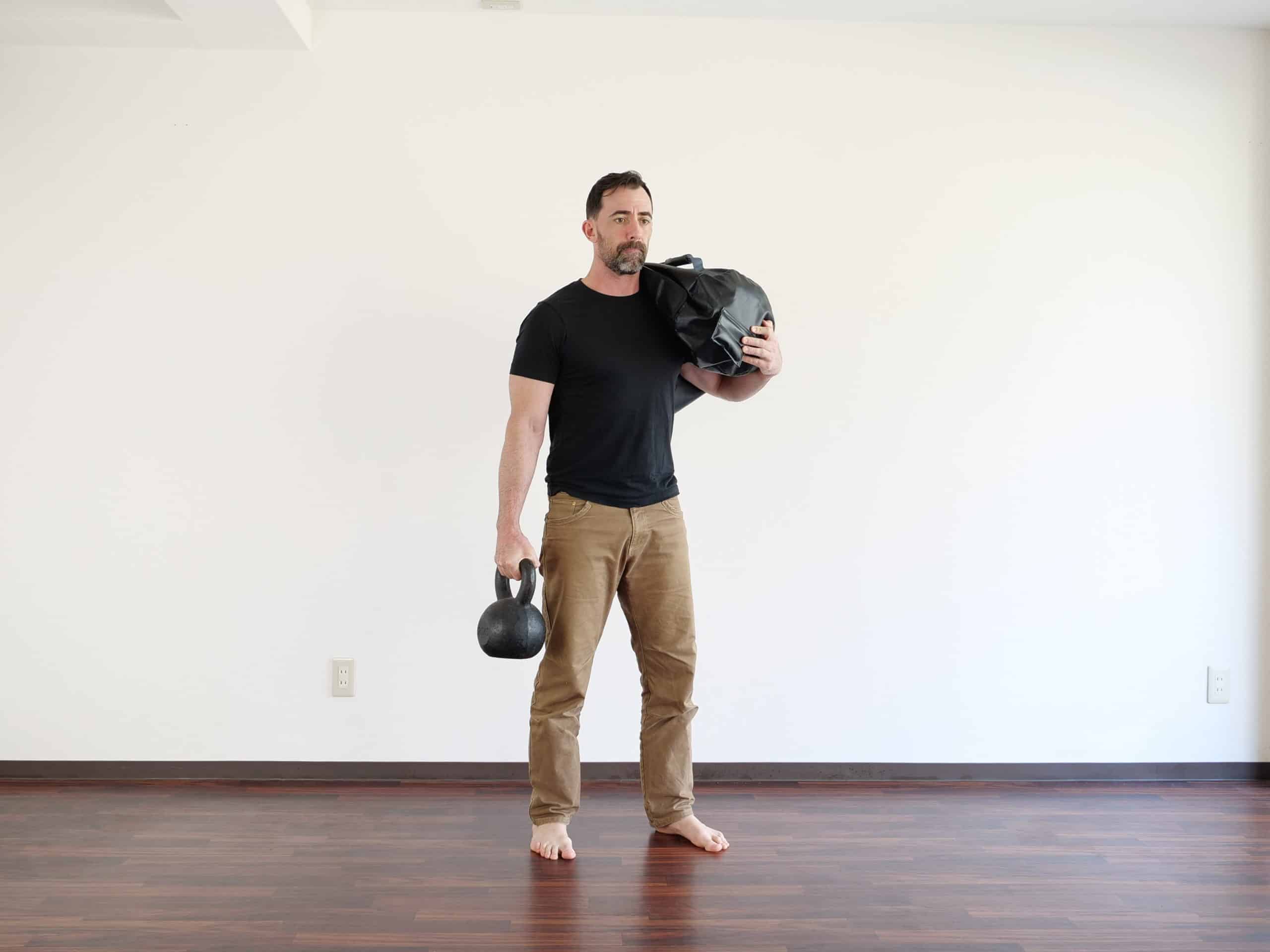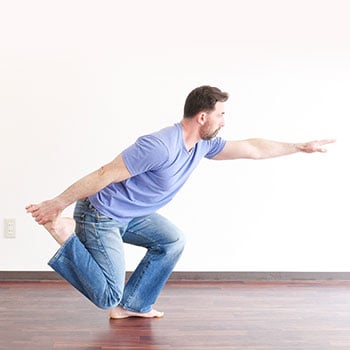Functional exercise at its heart should be training that improves your ability/performance in your everyday life responsibilities/duties and what you do for fun.
From carrying packages, to moving your couch, or just bringing the groceries in, carrying loads are a part of our daily lives and it’s important to have the confidence to do so without any anxiety of getting hurt or simply being unable to do them.
You really shouldn’t overthink this, because it’s fundamentally pretty simple.
Get something fairly heavy and carry it around for a while!
But it does help to have some good starting points to be safe and get some good practice in before you start to figure out what will work best for you.
And taking some weights for a stroll might make you some friends!
What are Loaded Carries?
Put simply, loaded carries are a class of exercises where you add weight to your body and walk. We’ll describe them in more detail below, but there are a lot of ways to do them to focus on the different qualities you wish to develop. You can hold the loads in both hands, one hand, wear it as a pack, or on your shoulders, and any combination of that all.
What are Loaded Carries Good For?
If we’re talking just about what muscles are being strengthened, there’s quite a few! Loaded carries improve your grip strength, shoulder rotator cuff, upper back, and your core muscles. They also are great for conditioning work without a lot of high impact forces, getting your heart rate up significantly!

Examples of Loaded Carry Exercises

- Farmer’s Walk
- Suitcase Carry
- Rack Carry
- Bear Hug Carry
- Overhead Carry
- Shoulder Carry
- Rucking
- Goblet Carry
- Zercher Carry
Benefits of Loaded Carry Exercises
It’s pretty obvious that training to carry stuff will get you better at… carrying stuff. But is it really worth adding to your routine as an exercise?
We think so. Here’s why:
Connection Between Your Lower and Upper Body
If you are familiar with what we do here at GMB Fitness you know that we teach a lot of locomotion (moving using all four limbs) and just as in the variety of locomotion patterns, loaded carries involve exerting force through our hands and feet in a coordinated fashion. But loaded carries do this in a pattern you are more familiar with right away, and that’s simple walking.
When you add significant loads to your gait, you’ll quickly get the awareness about how your core works and what it really does for you! This transfers directly to everyday activities like walking around and carrying lighter loads than in your training, and you’ll also likely notice benefits in your athletic endeavors. Throwing and kicking, in ball sports as well as combat sports, improves so much when this connection and “bridge” between your lower body and upper body.
Automatic Bracing at the Core
Speaking of the “core”, one other great benefit to loaded carries is how they take advantage of our bodies’ natural automatic core activation when we walk. There’s quite a lot of research in how our low back and deep abdominal muscles are used in gait, but for our purposes it’s enough to know that when we make sure we keep tall and level as we walk with added loads, we’ll be using our core. Then if we wish to further strengthen our core it’s just a matter of progressively heavier loads and/or an increase in walking speeds.
Practical Strength/Skill Development
There’s a reason why moving boxes sucks, we might be pretty strong when our feet are stable but when we have to move around with a load (and especially if that load moves around too) then we have to deal with those shifting forces. This is not a call to squat on balls or any of that silly stuff, but there’s great value in “adding stress to the gait pattern” (quote from Dan John).
The coordinated effort needed throughout your whole body to carry heavy loads is significant, from your grip to your toes you’ll notice the stimulus and will very quickly find out where you may benefit from extra work. And the beauty of finding that out, is you’ll likely find yourself progressing fast. Thank you “beginner gains”!
Loaded Carry Exercise Tutorial
| Loaded Carry Exercises | |
|---|---|
| #1 - Backpacking | • A sturdy backpack is a must! • One with a hip belt/strap helps a lot to keep from shifting |
| #2 - Farmer's Walk | • Load in both hands • Dumbells, kettlebells, bags with handles |
| #3 - Suitcase Carry | • Load in one hand • Equal work on each side |
| #4 - Sandbag Carry | • "Bear hug" style • Elbow crook (Zercher) style • Over shoulder style • While carrying load in free hand |
| #5 - Advanced Move: Fireman's Carry | • Carrying another person! |
Fundamentals of Loaded Carry Technique
Before you get started, let’s talk a little bit more about the fundamentals of doing loaded carries and what you should be thinking about while you do them.
Correct Posture for Carries
It really does defeat the purpose of the exercise if you perform them hunched over. Yes you’ll likely have a bit of form breakdown as you get tired and are ready to set the load down, and you shouldn’t think you need to be ramrod straight, but a good emphasis on a proper posture will get you the most benefit from your efforts.
Keep in mind the following four cues and you’ll be good to go.
- Keep Your Chest Up
- Roll Your Shoulders Down and Back
- Try to Keep Your Shoulders Level
- Keep Your Hips Under You

If you’re loading a backpack to carry, make sure to fit it tight to your body and keep an upright posture. Evil eye is optional.
Carrying is a Skill
Just because you’re lugging heavy stuff around doesn’t mean this is just a brute force caveman activity. Treat carrying heavy loads as a skill, because it is and just as we talked about above it’s a great skill to have in your toolbox. Keep those cues about proper posture in your head and think about why you are adding these into your training. With these we are working on improving our physical autonomy, our ability to handle physically whatever life throws at us. We want to do these to build our confidence, not just make us sweaty and tired.
Exploring Variations for Fun and Variety
The set and reps guidelines below are a good place to start for sure but don’t get too hung up on specific progressions and goals. As you continue to practice loaded carries you’ll see which ones are more difficult for you and which you seem to be “a natural” at. Of course the obvious thing to say is to work on your weaknesses (and you should!) But also work on your strengths! It’s good for you mentally, and also allows you to choose a carry that you can push hard with. And that’s always a nice thing to be able to do.
Programming for Adding Loaded Carries to Your Routine

One of the best things about carrying exercises like farmer’s walks and rucking is that you don’t need to rearrange your entire schedule to add them in.
How to Fit Loaded Carries into Your Training
In the GMB Method we emphasize cycling to improve the physical attributes you want to prioritize. You can do, and improve, a lot of things, you just shouldn’t do it all at once.
Here’s a few examples of how to incorporate carries into your current routine.
Adding Carries to Your Training Session
Pick one variation with a corresponding load and distance/time duration that fits with the rest of your workout that day.
- Heavy and short bursts in a strength focused session
- Lighter and more time/distance in a conditioning focused session
- Lighter and more complex in a skill based session
Standalone Loaded Carry Workouts
Several variations with multiple varied loads/distance/time
- Farmer’s Walks with heaviest manageable loads for several short sets
- Suitcase Carries with moderate loads for a couple of long sets
- Waiter Walks with light loads for one long set
End of a Session “Finisher”
Either once or twice a week depending upon your needs, choose one variation as a conditioning exercise to end your training.
- Farmer’s Walks with heavy load for one long set
- Sandbag Carry in a bear hug for one long set
- Suitcase Carry with a heavy kettlebell up an incline for one long set
How Much Weight Do I Start With?
Pick the carry you’d like to try first, I’d suggest the farmer’s carry or suitcase carry as your first try.
- Start light and just pick the weight up and simply stand and hold for 30 seconds.
- Do this a few times with both hands and with one hand, rest a bit and add weight, then note how you feel.
- Next choose your goal metric, time or distance.
- Start with half as much as you think you can do and focus on your posture/form.
- Add a bit of weight over the next 3 or 4 sets and you’ll find a nice place to start.
How Many Sets and Reps?
This is dependent upon the load, and the key formula is more sets of less time, and less sets of more time. A good way to start is to progress with the same weight and do more sets of less time/distance and then move to consolidating the time with less sets of longer duration/distance.
Time frames for heaviest loads would be 20 seconds to a minute, moderate loads for more endurance/conditioning would be 2 minutes to 5 minutes (plus).
So with that in mind:
For the Heaviest Loads
- Start with 3 sets of 20 seconds
- Then go to 2 sets of 30 seconds
- Then 1 set of 45 seconds and 1 set of 15 seconds
- And then finally to 1 set of 60 seconds
- Add a bit of weight over the next 3 or 4 sets and you’ll find a nice place to start.
This is just one example of a progression, you could do this or anything in between really. For lighter loads and longer durations the concept is the same, for example do 5 sets of 1 minute then progress to 3 sets of 90 seconds, and then eventually to 1 long set of 5 minutes. Be creative!
Should I Do Weighted Locomotion?
We talked earlier about how locomotion and loaded carries are very similar in how they emphasize a full body “connection”, taking advantage of the automatic core activation, but it doesn’t follow that loading your locomotion work would be an even better idea.
It MIGHT be useful if you are already moving very well with your locomotions but I’d suggest that you work on improving the quality of your movement even further (you can always improve that!) rather than loading yourself up with weight. Save adding weight for your weight training and to loaded carries instead.
Pick Something Up and Get Walking
Over the years, Ryan, Andy, and I have all used carries as part of our training. It’s simple, flexible, and extremely scalable to your needs and circumstances.
Give the exercises in this tutorial a try and let us know how you like them.
Loaded carries are a great example of integrated strength development, full body strength that will positively affect how you actually move and use your body. For more about how to do that, check out our program for developing this integral strength.
Use Skill-Based Training to Build Practical Strength
Integral Strength is a skill-based strength program that helps you build practical skills and strength that carry over into your beloved daily activities.






